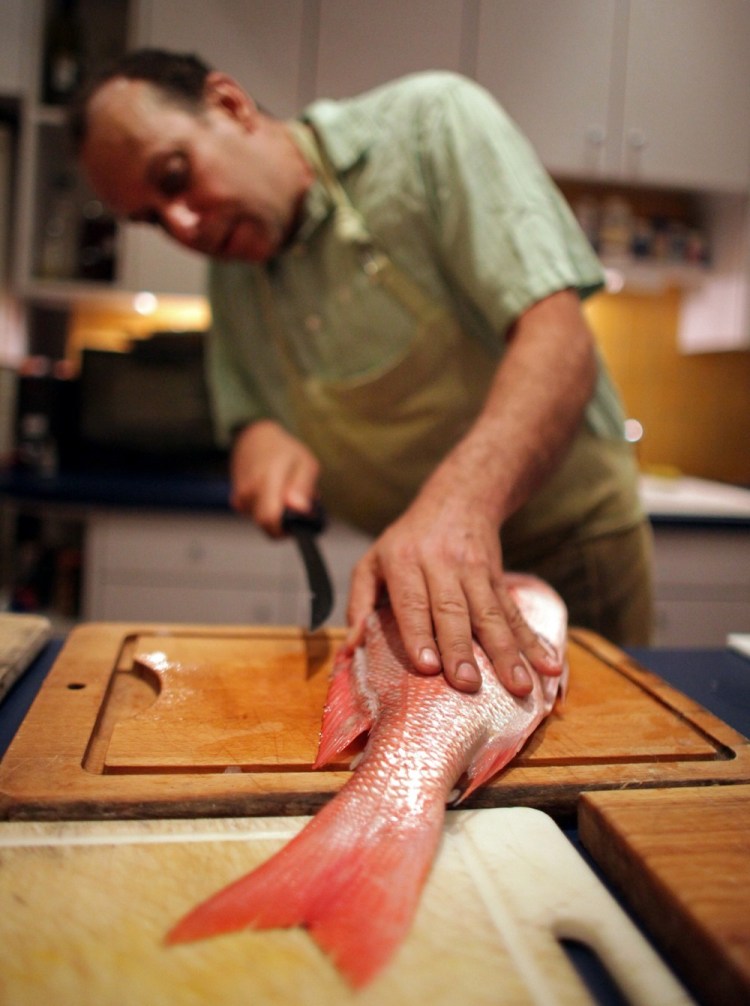Author Paul Greenberg was standing in his Manhattan kitchen, cleaver in hand. He had already fluidly removed two fillets from a gleaming red snapper, shipped overnight from the Gulf of Mexico. Now it was time to take off the head, which he would use to make a spicy Korean soup. “This,” he said with a laugh, “is where it gets gnarly.” Then with a swift chop he severed the fish’s head from its body.
It would have been easier to buy a few fillets or, for this dish, to ask a fishmonger for the head. (Sometimes they’ll give it to you free.) But Greenberg, best-selling author of “Four Fish: The Future of the Last Wild Food,” wanted to make use of a whole snapper in service of a larger point: Americans need to eat more American seafood.
It’s a point he discussed as a panelist at MaineFare in Belfast last month and one he makes compellingly clear in his new book, “American Catch: The Fight for our Local Seafood” (Penguin Press, June 2014). The United States controls more ocean than any other country on Earth. Yet despite our 2.8 billion acres of ocean, 94,000 miles of coastline and 3.5 million miles of rivers, 91 percent of the seafood Americans eat is imported.
It gets fishier, Greenberg says. Much of what we import is farmed; shrimp and tilapia top the list. Meanwhile, one-third of what we catch is sent overseas. “There are of course subtleties to the ridiculous international fish swap we’re engaged in here in America, but after three years of pounding my head against the data, what I realized is that we’re basically low-grading our seafood supply,” Greenberg said. “We’re sending the good wild American stuff that makes you heart-healthy and smart to Asia and importing all this farmed stuff from Asia that doesn’t really do too much for you from a health perspective.”
Moreover, American fisheries are some of the best managed in the world. After changes to fishery law in 2006, more U.S. fisheries than ever are making efforts to end overfishing, limit bycatch and more, said Margaret Spring, vice president of conservation and science at the Monterey Bay Aquarium. Now, just 3 percent of them carry the red (“avoid”) label in the aquarium’s Seafood Watch program. “The United States has emerged as a global leader,” she said in an e-mail.
There are many reasons why Americans don’t cook more seafood, domestic or imported. One of the biggest is that we are scared of fish. According to Greenberg’s sources in the seafood industry, surveys show that Americans tend to have three complaints about fish: “One, I don’t want to touch it. Two, I don’t know how to cook it. And three, I don’t want it smelling up my kitchen,” he said. That’s why so much of the fish America imports, such as tilapia, is odorless and all but tasteless: “a fried-dough delivery system,” Greenberg calls it. It’s also a lot cheaper. Wild boneless red snapper fillets, for example, cost $20 to $30 a pound. Imported tilapia, by comparison, maxes out at $10 a pound.
And so dressed in shorts, a green buttoned-down and a well-worn apron, Greenberg, 46, set out to show me that cooking fish need not be scary or super expensive. He started with a whole fish, which cut the cost considerably; a whole wild snapper at Whole Foods sells for $11.99 a pound. By using almost everything, Greenberg would make three meals for four from a single five-pound fish, bringing the cost of the snapper to less than $5 a serving. For the recipes, he chose a trio of Asian dishes from Vietnam, Korea and China, countries that buy and eat much of America’s wild fish.
Greenberg grew up in Greenwich, Conn. He learned to fish during what he calls “divorced dad fishing weekends,” and it soon became a consuming passion. Greenberg got his first boat when he was 13. At 16, he sold his first piece of journalism, a how-to on catching Martha’s Vineyard bonito, to a magazine called the New England Fisherman. Though he is now revered as a guru on seafood and sustainability, Greenberg admits he wasn’t always thoughtful about how he fished or how much he caught. There weren’t a lot of rules back in the 1970s, he remembers, “and when the fish were biting, it was hard to stop.”
Writing “Four Fish” and then “American Catch” changed the way he thought about fishing — and cooking fish at home. “After ‘Four Fish,’ the question I always got from people was, ‘How can you fish when you know fish are in such trouble?'” he said. “At that point, I think even I thought of fisheries as something that someone else was supposed to manage. I realized that I needed to be more mindful, too.”
Which brings us back to the fish head.
In America, we usually throw it away. Indeed, according to the Food and Agriculture Organization of the United Nations, Americans waste about 30 percent of the seafood they buy. But there is plenty of good meat in and around the head. Using a small paring knife and his fingers, Greenberg removed chunks of flesh from what’s known as the collar, or throat, and, after a few minutes in simmering water, the snapper’s cheeks as well. He also strummed his fingers along the bones (also called a rack) to remove any shreds of meat left behind after the fillets were removed. All told, he was able to salvage six ounces of meat, plenty for his Korean fish head soup. “I think of it as an honor to the fish,” Greenberg says. “If you are going to kill it, you should eat it all.”
The whole thing — once I got past the yuck factor — was a cinch. Into a large pot went the fish head and the rack and enough water to cover. After it had simmered for 10 minutes, Greenberg strained the liquid and added his vegetables and two kinds of Korean chilies, a powder called gochukaru and the spicy paste gochujang, made from chilies and fermented soybeans. Just before the stew came off the stove, Greenberg added the reserved fish meat. The result was a light but hearty broth that was magically refreshing and satisfying at the same time.
That left us with two fillets. With the first, Greenberg decided to make one of his favorite Vietnamese recipes, Cha Ca Thang Long, chunks of fried fish wrapped in lettuce with an array of sweet and spicy condiments. It was a bit of an odd choice for a super-fresh fillet, which you might think to steam or serve as seviche. But Greenberg had his reasons. “If you’re new to filleting fish, you may not end up with a perfect fillet,” he said. (See “How to fillet a whole fish,” online.)
That is a plus, but it’s hardly the only one. The dish is fresh (thanks, dill and mint), crunchy (ditto, peanuts), bright, sweet — and plenty spicy, if that’s how you like it. But Greenberg also loves the lettuce wraps because this is what he calls a “stone soup” recipe. You can use whatever you like in the dish (or whatever you have on hand): sesame seeds, basil, cucumber, even tomatoes. “That’s the nice thing about being American,” he says. “There aren’t a lot of rules. You can do what you want.”
For the second fillet, Greenberg wanted a recipe with strong flavors — flavors that could mask any fishiness after a few days in the fridge. Just the word “fishy” is enough to make me blanch. If a fish smells, shouldn’t you throw it away? “A little fishiness is normal and fine” if a fish isn’t right out of the water, says Greenberg. “That’s why every cuisine has a way of dealing with it.”
For the Chinese, two go-tos are ginger and vinegar. They combined beautifully with mushrooms and ground pork in a classic Beijing dish that Greenberg describes as what perfect Chinese takeout would taste like if takeout were perfect. He cut the fish into chunks, marinated them with ginger, sugar, sherry and egg, then coated them in cornstarch. Then he fried them in a wok until they were a gorgeous golden brown. Next, he stir-fried the pork and mushrooms with more ginger, garlic and scallions. From start to finish, the whole dish took 30 minutes.
Greenberg had at least one convert: me. Working with a whole fish made culinary and economic sense. But, I asked him, couldn’t I just buy a whole fish and ask the fishmonger to fillet it (at no extra charge) and give me the head, even the rack?
You could, he admitted. But it was clear Greenberg thought that would ruin some of the fun. “As one fisherman told me recently, ‘Americans aren’t hip to fish,’ ” he said. “We should be.”
Send questions/comments to the editors.





Success. Please wait for the page to reload. If the page does not reload within 5 seconds, please refresh the page.
Enter your email and password to access comments.
Hi, to comment on stories you must . This profile is in addition to your subscription and website login.
Already have a commenting profile? .
Invalid username/password.
Please check your email to confirm and complete your registration.
Only subscribers are eligible to post comments. Please subscribe or login first for digital access. Here’s why.
Use the form below to reset your password. When you've submitted your account email, we will send an email with a reset code.